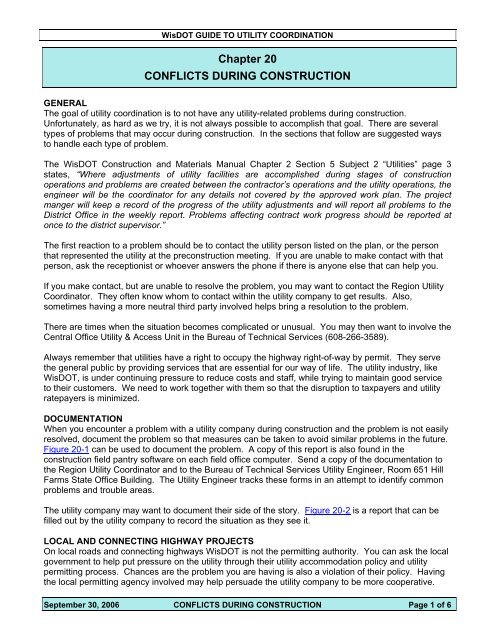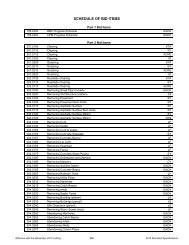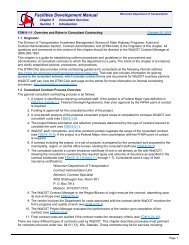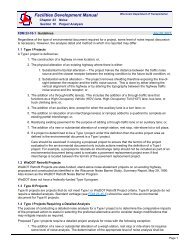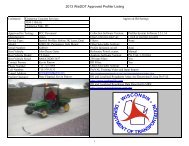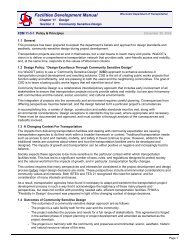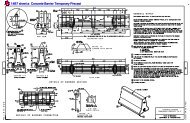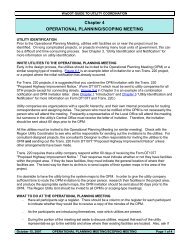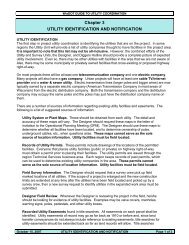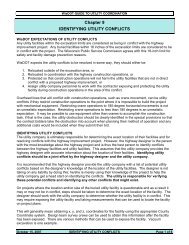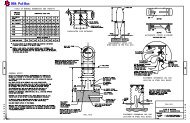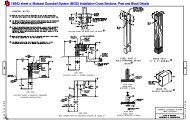Chapter 20 Conflicts During Construction - Wisconsin.gov
Chapter 20 Conflicts During Construction - Wisconsin.gov
Chapter 20 Conflicts During Construction - Wisconsin.gov
You also want an ePaper? Increase the reach of your titles
YUMPU automatically turns print PDFs into web optimized ePapers that Google loves.
WisDOT GUIDE TO UTILITY COORDINATION<br />
<strong>Chapter</strong> <strong>20</strong><br />
CONFLICTS DURING CONSTRUCTION<br />
GENERAL<br />
The goal of utility coordination is to not have any utility-related problems during construction.<br />
Unfortunately, as hard as we try, it is not always possible to accomplish that goal. There are several<br />
types of problems that may occur during construction. In the sections that follow are suggested ways<br />
to handle each type of problem.<br />
The WisDOT <strong>Construction</strong> and Materials Manual <strong>Chapter</strong> 2 Section 5 Subject 2 “Utilities” page 3<br />
states, “Where adjustments of utility facilities are accomplished during stages of construction<br />
operations and problems are created between the contractor’s operations and the utility operations, the<br />
engineer will be the coordinator for any details not covered by the approved work plan. The project<br />
manger will keep a record of the progress of the utility adjustments and will report all problems to the<br />
District Office in the weekly report. Problems affecting contract work progress should be reported at<br />
once to the district supervisor.”<br />
The first reaction to a problem should be to contact the utility person listed on the plan, or the person<br />
that represented the utility at the preconstruction meeting. If you are unable to make contact with that<br />
person, ask the receptionist or whoever answers the phone if there is anyone else that can help you.<br />
If you make contact, but are unable to resolve the problem, you may want to contact the Region Utility<br />
Coordinator. They often know whom to contact within the utility company to get results. Also,<br />
sometimes having a more neutral third party involved helps bring a resolution to the problem.<br />
There are times when the situation becomes complicated or unusual. You may then want to involve the<br />
Central Office Utility & Access Unit in the Bureau of Technical Services (608-266-3589).<br />
Always remember that utilities have a right to occupy the highway right-of-way by permit. They serve<br />
the general public by providing services that are essential for our way of life. The utility industry, like<br />
WisDOT, is under continuing pressure to reduce costs and staff, while trying to maintain good service<br />
to their customers. We need to work together with them so that the disruption to taxpayers and utility<br />
ratepayers is minimized.<br />
DOCUMENTATION<br />
When you encounter a problem with a utility company during construction and the problem is not easily<br />
resolved, document the problem so that measures can be taken to avoid similar problems in the future.<br />
Figure <strong>20</strong>-1 can be used to document the problem. A copy of this report is also found in the<br />
construction field pantry software on each field office computer. Send a copy of the documentation to<br />
the Region Utility Coordinator and to the Bureau of Technical Services Utility Engineer, Room 651 Hill<br />
Farms State Office Building. The Utility Engineer tracks these forms in an attempt to identify common<br />
problems and trouble areas.<br />
The utility company may want to document their side of the story. Figure <strong>20</strong>-2 is a report that can be<br />
filled out by the utility company to record the situation as they see it.<br />
LOCAL AND CONNECTING HIGHWAY PROJECTS<br />
On local roads and connecting highways WisDOT is not the permitting authority. You can ask the local<br />
<strong>gov</strong>ernment to help put pressure on the utility through their utility accommodation policy and utility<br />
permitting process. Chances are the problem you are having is also a violation of their policy. Having<br />
the local permitting agency involved may help persuade the utility company to be more cooperative.<br />
September 30, <strong>20</strong>06 CONFLICTS DURING CONSTRUCTION Page 1 of 6
WisDOT GUIDE TO UTILITY COORDINATION<br />
On connecting highways, every municipality should have a permitting process, but on local road<br />
projects you may find that the local unit of <strong>gov</strong>ernment does not have a utility accommodation policy<br />
and no permitting process. In these cases the local <strong>gov</strong>ernment probably won’t be of much assistance<br />
in solving the problem, but it still doesn’t hurt to try to enlist their support.<br />
CONTRACTOR’S RESPONSIBILITY<br />
Section 107.22 of the State of <strong>Wisconsin</strong> Department of Transportation Standard Specifications<br />
For Highway and Structure <strong>Construction</strong> (<strong>20</strong>05 Edition) states:<br />
107.22 Contractor's Responsibility for Utility Facilities, Property, and Services<br />
(1) The department expressly reserves for the proper authorities of the municipality in which the work is done<br />
the right to construct utility services in the highway or street, or to grant permits for the same, at any time.<br />
Coordinate and cooperate with utilities in the removal and rearrangement of existing facilities to minimize their<br />
service interruption and duplication of work by the utilities. At least 3 business days before breaking ground,<br />
the contractor shall notify the proper utility authorities that the contractor’s operations may affect their facilities<br />
including: streets, gas and water pipes, electric and other conduits, railroads, poles, manholes, catch basins,<br />
sewers, and other property. Never hinder or interfere with utility representatives in the protection or operation<br />
of their facilities. Obtain all necessary information regarding existing facilities. Protect existing facilities from<br />
damage and unnecessary exposure.<br />
(2) Obtain all necessary information regarding the planned installation of new facilities identified in the<br />
contract. Make proper provision and give proper notification so the utilities can install new facilities at the<br />
proper time without delay or unnecessary inconvenience. Do not pave over the location of a new<br />
underground facility, planned for installation concurrently with this contract, before installing the facility.<br />
(3) If the contractor damages or interrupts service, the contractor shall notify the utility promptly. Coordinate<br />
and cooperate with the utility in the repair of the facility. The department will determine who is responsible for<br />
repair costs as specified in <strong>Wisconsin</strong> statutes 66.0831 and 182.0175(2).<br />
(4) If the contractor finds facilities not identified in the contract, the engineer will determine whether<br />
adjustment or relocation of the facility is necessary to accommodate contract work. The engineer will arrange<br />
with the utility or the contractor to adjust or relocate the facility. If deemed necessary, the engineer will revise<br />
the contract as specified in 104.2.<br />
(5) If specified in the contract, the contractor and the department will comply with administrative rule, Trans<br />
2<strong>20</strong> of the <strong>Wisconsin</strong> administrative code.<br />
Please note that the contractor must coordinate and cooperate with utility owners, and it is the<br />
contractor’s responsibility to obtain all necessary information in regard to existing and planned utilities.<br />
FIELD CHANGES<br />
It is sometimes necessary to make changes to the plan during construction. Obviously, the utility had<br />
no way of knowing that these changes were going to take place, and therefore could not relocate prior<br />
to construction. The utility must be notified of such changes, and must be given adequate time to<br />
design and construct a relocation of their facility. The definition of adequate time is open to<br />
interpretation, and varies with the scope of work involved. Trans. 2<strong>20</strong>.05(13) states:<br />
“If, after the letting date of the highway improvement project, additional utility relocation or<br />
adjustment work is found necessary, the department shall notify the owner (utility). The<br />
department and the owner (utility) shall agree on a revised work plan.”<br />
This wording is applicable to all projects, WisDOT and the utility must agree on a reasonable timeframe<br />
to do the relocation work. It is important to note that the field change is the cause of any delays, not the<br />
utility company.<br />
UNKNOWN FACILITIES<br />
This problem has a few potential causes. The facility may not have been field located at the time the<br />
survey crews picked up the topography. The survey crew may have missed it, and not picked up the<br />
September 30, <strong>20</strong>06 CONFLICTS DURING CONSTRUCTION Page 2 of 6
WisDOT GUIDE TO UTILITY COORDINATION<br />
information. The information may have been picked up but never made it to the plans. The utility may<br />
not even be aware that the facility is there. (This happens most often in older portions of cities where<br />
records may not exist for older facilities, especially for clay pipe sewer systems.)<br />
Whatever the reason, there is a utility facility that is in the way of construction. Again, the first thing to<br />
do is to contact the person from the utility company listed on the plan, or the person that attended the<br />
preconstruction meeting. If they aren’t available, ask if there is anyone that can help you. If you are<br />
unable to make a satisfactory contact, and the problem cannot wait until the appropriate person is back<br />
in the office, contact the Region Utility Coordinator. While they cannot do anything about the people<br />
who are out of the office, they may have a suggestion as to whom else to call.<br />
When you make contact with someone, explain that you have found a facility that wasn’t shown on the<br />
plan and you need to have it relocated. Request a timeframe from them of when the work can be done.<br />
If the time seems unreasonable, ask if it can be expedited. It may be helpful to request a field meeting<br />
to discuss the situation.<br />
Sometimes the prudent thing to do is to adjust the highway plans to accommodate the newly<br />
discovered utility facility. The total costs and the time involved should be considered when making this<br />
decision.<br />
UNDETECTED CONFLICTS<br />
There are times when conflicts arise during construction that were not noticed beforehand. The utility<br />
facilities are shown correctly on the plan and there were no changes to the plan, but the utility company<br />
and the designer failed to notice a conflict and the conflict wasn’t resolved prior to construction.<br />
The responsibility for determining conflicts always lies with the utility company. However, no one is<br />
perfect, and utility company personnel are not as familiar with reading WisDOT plans as highway<br />
designers are. Regardless of how it happened, you are now stuck with a problem during construction.<br />
It doesn’t do any good to point fingers and rant and rave. That doesn’t solve the problem.<br />
Again, the first thing to do is to contact the person from the utility company listed on the plan, or the<br />
person that attended the preconstruction meeting. If they aren’t available, ask if there is anyone that<br />
can help you. If you are unable to make a satisfactory contact, and the problem cannot wait until the<br />
appropriate person is back in the office, contact the Region Utility Coordinator. While they cannot do<br />
anything about the people who are out of the office, they may have a suggestion as to whom else to<br />
call.<br />
When you make contact with someone, explain that you have a conflict with one of their facilities which<br />
wasn’t resolved prior to construction and you need to have it relocated. Request a timeframe from<br />
them of when the work can be done. If the time seems unreasonable, ask if it can be expedited. It may<br />
be helpful to request a field meeting to discuss the situation.<br />
The cause of the undetected conflict may be that the facility is not at the anticipated depth. If that is the<br />
case, document this by photographs and/or sketches. Shoot elevations on the exposed facility. Also,<br />
document the details in the project diary; it may be needed if there is a court case regarding delays to<br />
the contractor.<br />
Remember to document the location of the utility facility and the markings, including elevations<br />
where appropriate. There may be questions later regarding the exact location of the utility facility and<br />
its relationship to the planned roadwork.<br />
As long as time permits, the best solution is to have the utility relocated. That is what should have<br />
happened prior to construction. However, sometimes the prudent thing to do is to adjust our plans to<br />
September 30, <strong>20</strong>06 CONFLICTS DURING CONSTRUCTION Page 3 of 6
WisDOT GUIDE TO UTILITY COORDINATION<br />
accommodate the newly discovered conflict. The total costs and the time involved should be<br />
considered when making this decision. This solution only makes sense when the contractor has no<br />
other work to do and cannot wait for a delay, safety is a concern, or the public is intolerably<br />
inconvenienced.<br />
UNEXPECTED FIELD CONDITIONS<br />
This may occur when changes have been made to the topography since the survey work was done. A<br />
good example is a utility pole that was outside of the slope intercepts on the plan and therefore was not<br />
relocated because it was believed that there was no conflict. However, during construction it is<br />
discovered that a property owner altered the original terrain a few years ago and now the grading limits<br />
are such that the pole is in conflict. Or maybe drainage conditions are different than was anticipated,<br />
and a relocation is now required.<br />
In this case, no one is at fault. The utility relocated according to the information that was provided to<br />
them. The designers used the information that was provided to them. For some reason, actual field<br />
conditions are now different than what was used for the design and changes must be made.<br />
If you need the utility relocated, or exposed to determine if there is a conflict, you must contact the<br />
person from the utility company listed on the plan, or the person that attended the preconstruction<br />
meeting. If they aren’t available, ask if there is anyone that can help you. If you are unable to make a<br />
satisfactory contact, and the problem cannot wait until the appropriate person is back in the office,<br />
contact the Region Utility Coordinator. While they cannot do anything about the people who are out of<br />
the office, they may have a suggestion as to whom else to call.<br />
When you make contact with someone, explain that you have a conflict with one of their facilities<br />
because of a change in field conditions and that it needs to be relocated or exposed, whichever the<br />
case may be. Request a timeframe from them of when the work can be done. If the time seems<br />
unreasonable, ask if it can be expedited. It may be helpful to request a field meeting to discuss the<br />
situation.<br />
INCORRECTLY MARKED FACILITIES<br />
This problem is more serious. It can cause an extremely dangerous situation that may lead to injury<br />
and/or costly delays. The owner of a utility facility is responsible for accurately locating their facilities in<br />
the field. Sometimes this locating work is contracted out to various companies, but the ultimate<br />
responsibility lies with the utility.<br />
If you discover that a buried utility line has been incorrectly marked, document the markings and the<br />
facility location. Take photographs with a 6-foot rule indicating the scale if possible. At a minimum<br />
draw a sketch with appropriate dimensions showing the markings and the facility. This information<br />
should be placed in the project diary and the project files.<br />
The utility must be notified immediately. It is best to have one of their employees view the site before<br />
any markings are destroyed. They can verify the documentation you provide. If a utility line is<br />
damaged by construction activities because of the mis-marking, the utility should not be billing the<br />
contractor. The contractor should not be held liable, unless he was digging with power equipment<br />
within 18 inches of the markings (See ss.182.0175 – Figure 1-1). The utility should bear the cost of the<br />
repairs or may seek compensation from their locating service.<br />
This situation frequently requires immediate action and may be treated as an emergency. You should<br />
start by contacting the utility person on the plan, but if they are unavailable, talk to anyone from the<br />
utility and explain the situation. They should be able to put you in touch with the proper people within<br />
the utility. If you are unable to contact anyone at the utility, contact the Region Utility Coordinator or<br />
Region Permit Coordinator for assistance on how to proceed.<br />
September 30, <strong>20</strong>06 CONFLICTS DURING CONSTRUCTION Page 4 of 6
WisDOT GUIDE TO UTILITY COORDINATION<br />
Remember to document the location of the utility facility and the markings, including elevations<br />
where appropriate.<br />
FACILITIES SHOWN ON PLAN INCORRECTLY<br />
There are times when for some reason the utility facilities are shown incorrectly on the plan. There may<br />
have been a survey error, it may have been field located incorrectly, it may have been inadvertently<br />
moved during the design process, or perhaps there was a glitch in the software program or in<br />
converting it from one format to another. At any rate, the location of the utility facility on the plan is<br />
different from where it is in the field. This may pose a problem for the contractor and add to their costs.<br />
This is indeed unfortunate and may be costly, but the general note on the plan states, “The locations<br />
of existing and proposed utility installations on the plans are approximate. There may be other<br />
utility installations within the project area that are not shown.” This disclaimer alerts the<br />
contractor that conditions may be different than what is depicted on the plan. The designer does their<br />
best to accurately portray the expected work site conditions, but there is no guarantee. Everyone that<br />
bids on the job is on an equal basis, and does so knowing the information is only approximate.<br />
A discrepancy of 15 to <strong>20</strong> feet may be a legitimate reason for a claim for additional work depending on<br />
the specific situation, but a discrepancy of 1 to 2 feet is not.<br />
FAILURE TO FOLLOW WORKPLAN<br />
This is a common problem, unfortunately. There may be various reasons why the utility did not<br />
complete their work as stated in the work plan, including weather delays and storm damage. Whatever<br />
the reason, the problem is that they have not relocated according to their plan.<br />
On Trans. 2<strong>20</strong> projects, the utility is responsible for any damages to the contractor for delays caused by<br />
the utility if it did not follow the approved work plan. The contractor can sue the utility for those<br />
damages. The WisDOT would act as a neutral third party, providing documentation and testimony<br />
regarding the facts of the project.<br />
For non-Trans. 2<strong>20</strong> projects, there is no recourse for the contractor other than to file a claim with<br />
WisDOT for additional time or additional expenses. Local road projects and most urban projects are<br />
non-Trans. 2<strong>20</strong>. The contractor may file a claim with the utility, and if the situation is well documented,<br />
the utility may pay the claim. However, the legal obligation is not as clear as it is on Trans. 2<strong>20</strong><br />
projects.<br />
When a problem is discovered, contact the person from the utility company listed on the plan, or the<br />
person that attended the preconstruction meeting. If they aren’t available, ask if there is anyone that<br />
can help you. If you are unable to make a satisfactory contact, and the problem cannot wait until the<br />
appropriate person is back in the office, contact the Region Utility Coordinator. While they cannot do<br />
anything about the people who are out of the office, they may have a suggestion as to whom else to<br />
call.<br />
When you make contact with someone, explain that their facility which is in conflict with the highway<br />
project hasn’t been relocated as promised and you need to have it relocated. Let them know that their<br />
failure to relocate quickly will hold up our contractor. Request a timeframe from them of when the work<br />
can be done. If the time seems unreasonable, ask if it can be expedited. It may be helpful to request a<br />
field meeting to discuss the situation. Remember that at this point in time our main concern is to get<br />
the facility relocated quickly, not who will have to pay damages. Focus on getting the problem<br />
resolved, not on placing blame or making threats regarding future actions.<br />
September 30, <strong>20</strong>06 CONFLICTS DURING CONSTRUCTION Page 5 of 6
WisDOT GUIDE TO UTILITY COORDINATION<br />
On Trans. 2<strong>20</strong> projects, if you are unable to get a quick resolution to the problem, it may be a good idea<br />
to write a letter to the utility company notifying them that they are in violation of Trans. 2<strong>20</strong> and that they<br />
may be liable to the highway contractor for any utility-related delay damages. A sample Trans. 2<strong>20</strong><br />
Violation letter is shown in Figure 1-18.<br />
September 30, <strong>20</strong>06 CONFLICTS DURING CONSTRUCTION Page 6 of 6
WisDOT GUIDE TO UTILITY COORDINATION<br />
September 30, <strong>20</strong>06 UTILITY PROBLEM DOCUMENTATION REPORT Figure <strong>20</strong>-1
Project ID:<br />
Title:<br />
Subtitle:<br />
Highway:<br />
County:<br />
WisDOT GUIDE TO UTILITY COORDINATION<br />
Utility Problem <strong>During</strong> <strong>Construction</strong> Documentation Report<br />
Utility Company Version<br />
WisDOT Project Manager Name (If known):<br />
Date Utility Company Notified:<br />
Name of Highway Contractor/Subcontractor:<br />
Date of Report:<br />
Date Remedied:<br />
Nature of Problem:<br />
Unforeseen conflict (not identified during the design process)<br />
Existing (at time of design) utility facility shown incorrectly on plan<br />
Utility facility not shown on plan<br />
Facility not placed in compliance with permit<br />
Plan Change<br />
Erosion Control<br />
Traffic Control<br />
Operator Error<br />
Facility location marked incorrectly<br />
Other<br />
Details – explain what happened:<br />
(Include location, elevation of buried utility facility if shallow or cut, pictures, attach plan and cross<br />
section sheets as needed, anything that might help explain the situation.)<br />
Additional follow-up needed? (Check one) Yes No<br />
If Yes, please explain:<br />
Submitted by:<br />
Utility Company:<br />
Type of utility: (Check one)<br />
Gas Electric CATV Telecommunications<br />
Water Sewer Pipeline Other<br />
Send a copy of this form to: Region Utility Coordinator, address, city, state<br />
September 30, <strong>20</strong>06 UTILITY PROBLEM DOCUMENTATION REPORT-UTILITY VERSION Figure <strong>20</strong>-2


